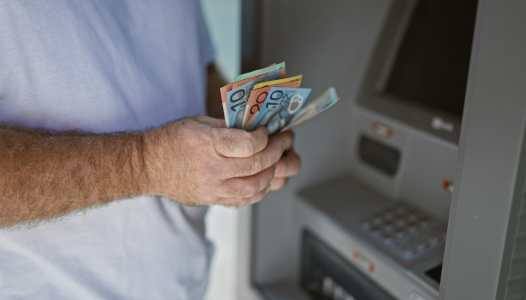Why are Australians resisting cashless future despite digital payment bloom?
By
Gian T
- Replies 52
In an age where digital wallets and contactless payments are becoming the norm, it's easy to assume that the traditional cash system is on its way out.
However, despite the surge in digital transactions, Australians are surprisingly resilient in holding onto their banknotes and coins.
The question is, why is there such a steadfast refusal to go completely cashless down under?
The answer lies in the regional and remote communities that form a significant part of the country's landscape.
These areas, often overlooked in the digital revolution, continuously rely on cash for day-to-day transactions.
Recent data from the Reserve Bank of Australia revealed that Australians made over 30 million ATM cash withdrawals in February, marking a 3.6 per cent increase compared to the same month in the previous year.
This resurgence of cash withdrawals, the highest collective sum since July 2020, suggested a backlash against the push for a cashless society.
During a segment on Sunrise, ING financial expert Matt Bowen discussed the current state of cash usage in Australia.
‘If you’re one of the few Aussies spending your $50 and $20 notes, you are in the minority. Cash has declined significantly,’ Bowen said.
‘About 70 per cent of transactions face-to-face in 2007 were using cash, it is down to around 13 per cent now. Will we see the decline of cash? I’m not sure.’
‘There is still around 25 per cent of Aussies who live in regional and remote communities still very reliant on cash for day-to-day transaction, which is unlikely to change any time soon,’ he added.
‘There is still a big portion of consumers that believe you actually spend more when you’re tapping your card.’
‘It is easier to save money and control your budget when you’re using cash, and, of course, the one thing we can’t replicate is that feeling of the $20 bill falling out of a birthday card from grandma.’
‘That’s something that can’t be replicated with a bank transfer.’
The debate between cash and digital payments has escalated in recent months, particularly with the significant turnout for Cash Out Day in April.
This event urged individuals to withdraw money from ATMs, symbolising their ongoing reliance on cash.
According to ATM provider Next Payments, cash withdrawals nationwide surged by 6.2 per cent compared to 2 April 2023.
Jason Bryce, a campaigner for the Cash Welcome, expressed concerns that Australians were ‘fettered against their will into a cashless society.’
He attributed this trend to banks' reluctance to bear associated costs despite many Australians still preferring to use cash.
‘Banks can’t create a cashless transaction system that’s 100 per cent reliable, that’s 100 per cent private and is surcharge-free and these are the things people love about cash.’ Bryce said.
In related news, Australia's move towards a cashless society sparked widespread concern among the majority.
These concerns range from worries about excluding certain demographics to issues of economic equality and the potential for increased banking and card fees. For detailed information, you can find more here.
 Do you prefer cash transactions over digital ones? Have you experienced any challenges in accessing cash in your community? Share your stories and opinions in the comments below.
Do you prefer cash transactions over digital ones? Have you experienced any challenges in accessing cash in your community? Share your stories and opinions in the comments below.
However, despite the surge in digital transactions, Australians are surprisingly resilient in holding onto their banknotes and coins.
The question is, why is there such a steadfast refusal to go completely cashless down under?
The answer lies in the regional and remote communities that form a significant part of the country's landscape.
These areas, often overlooked in the digital revolution, continuously rely on cash for day-to-day transactions.
Recent data from the Reserve Bank of Australia revealed that Australians made over 30 million ATM cash withdrawals in February, marking a 3.6 per cent increase compared to the same month in the previous year.
This resurgence of cash withdrawals, the highest collective sum since July 2020, suggested a backlash against the push for a cashless society.
During a segment on Sunrise, ING financial expert Matt Bowen discussed the current state of cash usage in Australia.
‘If you’re one of the few Aussies spending your $50 and $20 notes, you are in the minority. Cash has declined significantly,’ Bowen said.
‘About 70 per cent of transactions face-to-face in 2007 were using cash, it is down to around 13 per cent now. Will we see the decline of cash? I’m not sure.’
‘There is still around 25 per cent of Aussies who live in regional and remote communities still very reliant on cash for day-to-day transaction, which is unlikely to change any time soon,’ he added.
‘There is still a big portion of consumers that believe you actually spend more when you’re tapping your card.’
‘It is easier to save money and control your budget when you’re using cash, and, of course, the one thing we can’t replicate is that feeling of the $20 bill falling out of a birthday card from grandma.’
‘That’s something that can’t be replicated with a bank transfer.’
The debate between cash and digital payments has escalated in recent months, particularly with the significant turnout for Cash Out Day in April.
This event urged individuals to withdraw money from ATMs, symbolising their ongoing reliance on cash.
According to ATM provider Next Payments, cash withdrawals nationwide surged by 6.2 per cent compared to 2 April 2023.
Jason Bryce, a campaigner for the Cash Welcome, expressed concerns that Australians were ‘fettered against their will into a cashless society.’
He attributed this trend to banks' reluctance to bear associated costs despite many Australians still preferring to use cash.
‘Banks can’t create a cashless transaction system that’s 100 per cent reliable, that’s 100 per cent private and is surcharge-free and these are the things people love about cash.’ Bryce said.
In related news, Australia's move towards a cashless society sparked widespread concern among the majority.
These concerns range from worries about excluding certain demographics to issues of economic equality and the potential for increased banking and card fees. For detailed information, you can find more here.
Key Takeaways
- Cash withdrawals in Australia have increased, with 30,859,700 ATM cash withdrawals made in February, up 3.6 per cent compared with the previous month.
- Regional and remote Australian communities still rely on cash for day-to-day transactions, with cash unlikely to disappear any time soon.
- A financial expert suggested that using cash can help individuals save money and control their budgets better than using cards.
- There's a sentiment among some Australians that cash transactions offer benefits that digital ones cannot, such as reliability, privacy, and no surcharge, leading to resistance against a fully cashless society.










